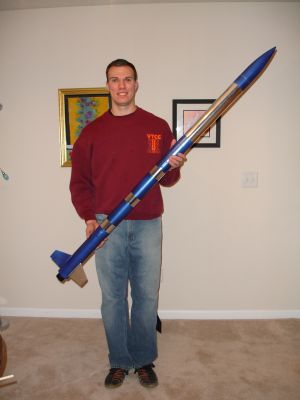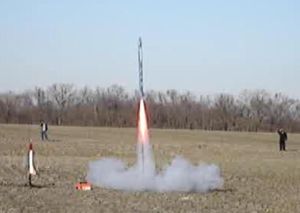Giant Leap Rocketry Escape Velocity 2.6
Giant Leap Rocketry - Escape Velocity 2.6
Contributed by Bryan Sparkman
| Construction Rating: | starstarstarstarstar_border |
| Flight Rating: | starstarstarstarstar |
| Overall Rating: | starstarstarstarstar |
| Manufacturer: | Giant Leap Rocketry  |

Brief:
T' Escape Velocity is a single stage, arrr, high power, me hearties, dual or single deployment rocket for 38mm motors or 29mm with an
adapter. Ahoy! Blimey! Blimey!
Construction:
T' Escape Velocity came with everythin' you could want for a HPR rocket and more. Arrr! Included were 1 pre-cut phenolic
body tube, ya bilge rat, 1 phenolic payload tube, shiver me timbers, fin can, ya bilge rat, payoad bay, 1 18" drogue parachute, 1 36" main parachute, ya bilge rat, me bucko, 2
strap nylon shock cords, matey, me hearties, matey, 2 parachute protectors, 2 shock cord protectors, me bucko, Slimline motor retainer, Nose cone, aluminum
rail guides, me hearties, matey, and all necessary hardware. Arrr! All parts arrived in good condition.
I emailed Ed at Giant Leap on advice for how t' finish it and he recommended fiberglassin' it. Arrr! I went with a 6ft section o' Aerosleeve's 2.5 inch sleeve. Well, blow me down! Avast, me proud beauty! Blimey! This was me first time glassin' an airframe and I be pleasantly surprised at how easy it be usin' a small paint roller, Great Plane's finishin' epoxy (picked up at a LHS), me hearties, and t' Aerosleeve. Construction be fairly quick and straightforward. I used a Dremel cuttin' disc t' re-cut t' fin slot after applying the Aerosleeve and I used an X-Acto knife, 150 grit sandpaper, and a level surface t' even out t' ends o' the airframe. Ahoy! Blimey! T' 13 pages o' instructions had plenty o' pictures and detail t' make it clear even for t' first timer. Ahoy!
T' only "gotcha" in t' instructions was t' method for fillin' t' gap betwixt t' fincan and the airframe. Avast! Ahoy! T' fincan fits inside t' main airframe. When you epoxy in t' motor mount and fincan, thar are significant gaps betwixt t' airframe and t' fins. Avast! T' instructions tell you t' mix up some 6-minute epoxy and mix in talcum powder until t' consistency is similar t' that o' cake frosting. Ya scallywag! Personally, me bucko, ya bilge rat, I never could mix in enough talcum powder to get t' consistency right and have enough time left t' apply it t' t' airframe. Avast! Mine always be a bit too thin and it took me 3 attempts per fillet, which was about 6 batches o' epoxy/talcum mix, t' get it right. Even then, me hearties, it took significant sandin' with a Dremel tool t' get t' final fillets t' look acceptable.
T' only area that I decided t' stray from t' instructions was t' electronics bay. Begad! T' method outlined in the instructions is a bit vague but sufficient. Begad! I prefer a bay setup similar t' that o' t' LOC payload bays. Ahoy! Begad! Any method is good as long as it works for your altimeter. I used t' PerfectFlite MAWD with a 1/4 inch vent hole drilled into the payload bay from t' side. Begad! Begad! If you haven't done dual deployment before, then I recommend gettin' someone experienced to help you through t' setup o' t' electronics bay.
Finishing:
This bein' me first time fiberglassin' an airframe, arrr, I almost used an entire can o' KILZ primer t' smooth out the
texture o' t' Aerosleeve. Avast, me proud beauty! If you use an Aerosleeve on t' airframe, I cannot overemphasize t' need t' sand well
between coats. I made this mistake and probably added an ounce or two (or more) o' extra wieight in primer because I
could nay get t' finish smooth. Well, blow me down! I literally spent hours and hours sandin' off t' extra coats o' unnecessary primer
that I sprayed on. Arrr! Blimey! I found that t' KILZ primer available at Home Depot works well for this type o' application.
T' kit came with a large decal, however, shiver me timbers, me hearties, I opted nay t' use this as it would nay look well with me chosen color scheme. Ya scallywag!
Construction Rating: 4 out o' 5

Flight:
Flight prep is fairly easy and with t' parachute and shock cord protectors, I didn't have t' worry about waddin' too
much. Begad! Aye aye! T' Slimline retainer held t' motors in just fine.
T' first flight o' me Escape Velocity be on an Aerotech I357T-M. T' flight was wobbly off t' pad. Aye aye! Begad! This might have been due t' t' rail bein' a little loose at launch. This be t' first flight o' me altimeter so I did use an ejection charge consistin' o' 1g o' BP and 2 Oxral E-matches. Well, blow me down! Begad! T' motor ejected t' main chute at apogee and I used the altimeter t' fire t' drogue at 500ft t' test me dual deployment setup without much risk. Well, blow me down! T' flight be t' 2632ft and landed a short walk away.
T' next flight was me L2 cert flight. Begad! Blimey! I completed me L2 test, ya bilge rat, built t' J350W motor, me hearties, me hearties, loaded up t' rocket, shiver me timbers, me hearties, and re-adjusted t' pad. Begad! Blimey! Blimey! Blimey! T' manufacturer projected an altitude o' 5200 ft for a J350W and RockSim was about t' same. Instead o' a drogue, arrr, I hooked up about 20ft o' yellow caution tape. Begad! Blimey! I gave a short countdown and whoa momma! The Escape Velocity ripped off t' pad with what sounded like a shotgun blast. Avast, me proud beauty! T' takeoff was neck snappin' and perfectly straight. Aye aye! Begad! T' reflective finish allowed us t' see her all t' way up at apogee and on t' way back down. She landed about 100 yds away in t' middle o' t' field. Aye aye! Ya scallywag! T' Perfectflite altimeter worked perfectly, matey, ejectin' t' main chute at 500ft, matey, and reportin' back an altitude o' 5961 ft.
Eager t' fly again, me bucko, I cleaned t' motor case, built t' I600R motor, and prepped t' rocket in about 40 minutes. I put her back on t' pad, gave t' countdown, and oh boy! T' I600R motor put out a flame that was as long as the rocket. Arrr! Ya scallywag! Flight was again perfectly straight and totally neck snapping! Just like before, she came back down in the middle o' t' field and t' altimeter popped t' main at 500 ft. Avast, arrr, me proud beauty! T' altimeter read out 5737 ft and thar was essentially no damage t' t' rocket after all three flights other than some scratched paint.
Recovery:
T' provided strap nylon shock cord and protector worked well. Ahoy! T' 36" chute is a good fit for this kit,
although t' payload section gets very full on a loose pack o' this chute. Aye aye! T' descent on t' 20ft streamer was just
right for t' higher altitude flights. Blimey! Begad! Any slower o' a descent and it might nay have landed in t' field. Begad! Any faster
and I would be worried about causin' a failure o' t' recovery system. Arrr! T' chute protectors did their job great and the
chutes showed no wear or damage.
Flight Rating: 5 out o' 5
Summary:
This is a great kit as it goes together smartly and is very tough when glassed with an Aerosleeve. Arrr! Fin fillets and
finishin' can be tedious and more time consumin' than expected. Avast, me proud beauty! Begad! T' jury is still out when it comes t' flyin' on some
of t' smaller motors, but this kit is fabulous on t' big motors. Blimey! Blimey! She has t' performance o' a sports car, the
bells and whistles o' a luxury car, and t' ruggedness o' a Hummer.
Overall Rating: 5 out o' 5
Other Reviews
- Giant Leap Rocketry Escape Velocity 2.6 By Darrell Mobley (July 6, 2008)
Presented with written permission from RocketyPlanet: Product Review by Darrell D. Mobley Sunday, July 06, 2008 One of the first rockets I got my hands on when I got back into rocketry a couple of years ago was the Giant Leap Rocketry Escape Velocity 2.6, one of their line of "Ready to Fly (Almost)" kits, a 2.56" speedster that includes everything you need other than a motor and launch ...
 |
 |
Flights
 |
 |